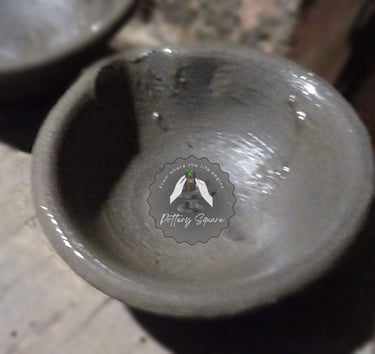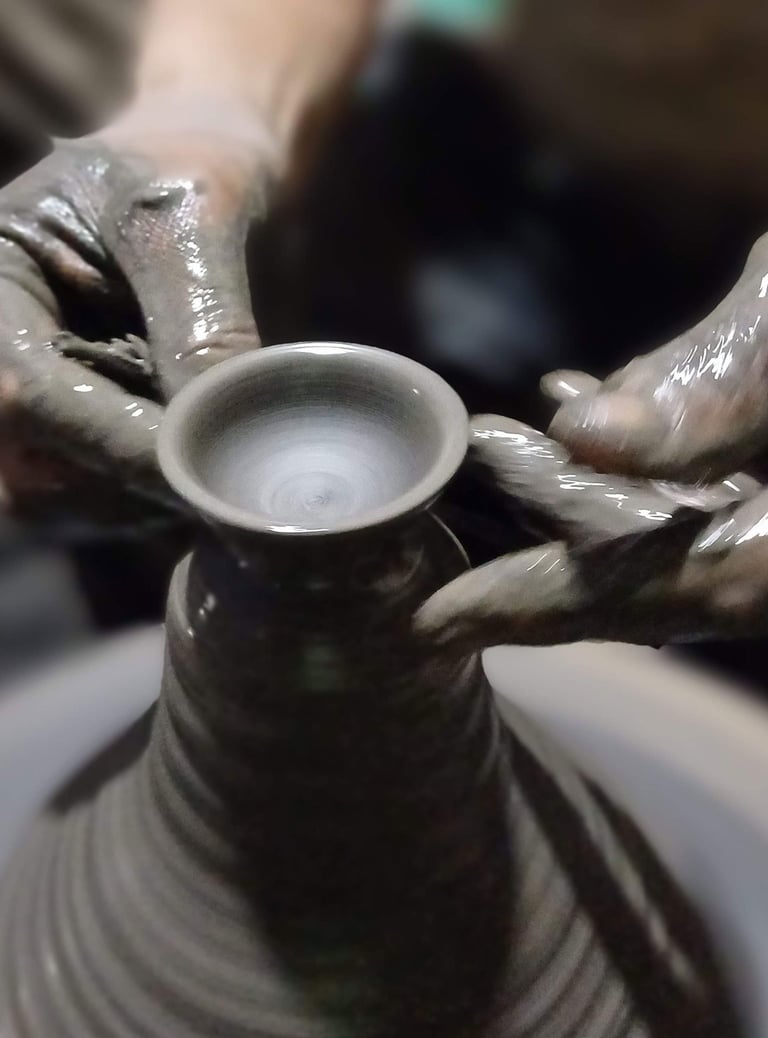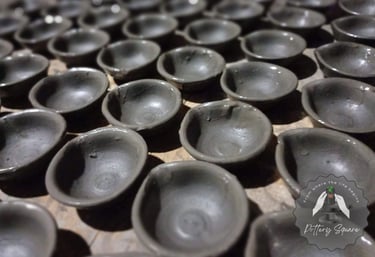
A Zero Energy Tradition - Celebrating Laxmi Puja and Dipawali / Tihar on with Eco-Friendly Wet Clay Lamps (माटाेकाे पाला)
POTTERYRESEARCH PAPER
Pottery Square
11/9/20235 min read
Introduction (English)
Dipawali, also known as Tihar in Nepal, is a beautiful and culturally rich festival celebrated with immense enthusiasm and reverence. This Festival of Lights, with its series of rituals and ceremonies spanning several days, is a time to rejoice, togetherness, and spiritual awakening. It signifies the victory of light over darkness, good over evil, and the deep connection between humans and nature. Among the various customs and traditions that adorn Tihar, the lighting of traditional clay lamps, or 'diyos,' holds a special place. These eco-friendly lamps, made of clay, have been at the heart of these celebrations, illuminating our homes with a warm, welcoming glow while requiring zero energy to produce.
परिचय (Nepali)
नेपालमा तिहार भनेर चिनिने दीपावली अत्यन्तै उत्साह र श्रद्धाका साथ मनाइने सुन्दर र सांस्कृतिक रूपमा धनी पर्व हो। यो उज्यालाेकाे पर्व, यसको अनुष्ठान र समारोहहरूको श्रृंखला साधारणतया पाँच दिनकाे हुन्छ । रमाईलो, एकता र आध्यात्मिक, दिदी भाईकाे मिलन, न्हुँदया नेपाल सम्वतकाे सुरूवातको समय हो। यसले अन्धकारमाथि उज्यालोको विजय, खराबीमाथि असल र मानव र प्रकृतिबीचको गहिरो सम्बन्धलाई जनाउँछ। तिहारलाई सजाउने विभिन्न रीतिरिवाज र परम्पराहरू मध्ये, परम्परागत माटोको बत्ती बाल्ने, वा 'पाला' ले विशेष स्थान राख्दछ । माटोबाट बनेका यी पर्यावरण-मैत्री बत्तीहरू यी उत्सवहरूको केन्द्रबिन्दु बनेका छन्, जसले उत्पादन गर्न शून्य ऊर्जा आवश्यक हुँदा हाम्रा घरहरूलाई न्यानो, स्वागतयोग्य चमकले उज्यालो पार्दछ ।
During Laxmi Puja and Tihar, the significance of wet clay lamps holds a special place. These lamps, made from moist clay, are an integral part of the rituals performed during these festivals in Nepal. The use of wet clay lamps symbolizes the invitation of the goddess Laxmi, the Hindu goddess of wealth and prosperity, into one's home. It is believed that the goddess Laxmi is attracted to the light emitted by these lamps, and her blessings are bestowed upon those who offer prayers and light them. Wet clay lamps are traditionally handcrafted by skilled pottery makers/crafters. They are filled with oil and a cotton wick, which is lit during the puja ceremony. The warm glow of these lamps not only illuminates the surroundings but also signifies the ushering in of prosperity and happiness into one's life. Thus, the wet clay lamps or Deyos or Palas hold great significance in Laxmi Puja and Tihar, symbolizing the divine presence and bestowing blessings upon devotees.
Dipawali , also known as the Festival of Lights, is one of the most significant Hindu festivals celebrated worldwide. During this auspicious occasion, the lighting of clay lamps, called diyo or palas, holds immense importance. These small lamps are filled with oil and have a cotton wick, which is lit to create a warm and inviting glow. The significance of these wet palas lies in the belief that they symbolize the victory of light over darkness and good over evil. Lighting diyo not only illuminates our homes but also dispels negativity and brings positive energy into our lives. It is believed that the warm glow of the diya attracts Goddess Lakshmi, the goddess of wealth and prosperity, to bless our homes. Thus, the tradition of lighting wet palas during Dipawali is a way of invoking blessings, spreading light, and fostering a sense of unity and joy among families and communities.
The Significance of Dipawali Wet Palas
The Significance of Wet Clay Lamps (पाला) in Laxmi Puja and Tihar
Zero Energy Sustainable Creation
One of the most remarkable aspects of eco-friendly clay lamps is their method of production. These lamps are meticulously crafted by skilled pottery makers, who use their hands and simple tools to shape the clay into exquisite forms. This traditional and manual process has been passed down through generations, preserving the essence of the art and ensuring the creation of these lamps consumes zero external energy. By eschewing the use of machines, these pottery makers pay homage to the traditions of their ancestors and conserve energy and resources in the process.







Eco-Friendly Features
Eco-friendly clay lamps boast a multitude of sustainable features:
· Biodegradability: Crafted from natural clay, these lamps are entirely biodegradable. This means that when their life cycle ends, they return to the earth without causing harm to the environment, in stark contrast to non-biodegradable alternatives.
· Sustainable Sourcing: The clay used for these lamps is typically sourced locally, significantly reducing the carbon footprint associated with transportation. By supporting local clay artisans, it contributes to the regional economy by reducing ecological impact.
· Minimal Energy Consumption: Once lit, these lamps require only a small amount of oil to provide a warm, sustainable source of light. This minimal energy consumption makes them an ideal choice for eco-conscious celebrations.
· Supporting Local Artisans: Purchasing eco-friendly clay lamps directly supports local artisans and potters, many of whom have been carrying on this ancient craft for generations. This not only preserves traditional craftsmanship but also provides these artisans with a sustainable livelihood.
पर्यावरण मैत्री गुणहरू
माटोको पाला तथा दिगाे पर्यावरण मैत्री हुनाका कारक तत्वहरू :
प्रकृतिमा सजिलै घुलिने : प्राकृतिक माटोबाट बनाइएका यी बत्तीहरू पूर्णतया बायोडिग्रेडेबल हुन्छन्। यसको मतलब यो हो कि जब तिनीहरूको जीवन चक्र समाप्त हुन्छ, तिनीहरू वातावरणलाई हानि नगरी पृथ्वीमा फर्कन्छन्, गैर-बायोडिग्रेडेबल विकल्पहरूको विपरीत एक अतुलनिय उपयाेग ।
दिगो स्रोत: यी बत्तीहरूको लागि प्रयोग गरिएको माटो सामान्यतया स्थानीय रूपमा उपलब्त्ध स्रोत साधनबाट गरिन्छ, यसले यातायातसँग सम्बन्धित कार्बन उत्सर्जनलाई उल्लेखनीय रूपमा घटाउँदछ । स्थानीय माटो कारीगरहरूलाई समर्थन र यस ब्यवसायलाइ हाैसला तथा पेशा उजागर गर्दै देशकाे अर्थतन्त्रमा ढुलाे योगदान पर्याउन सक्दछ ।
न्यूनतम ऊर्जा खपत: थाेरै मात्रामा तेल र कपडा अथवा कपासकाे वत्तिमात्र प्रयाेग गरि न्यानो, दिगो प्रकाशको स्रोत आवश्यकता पर्दछ । यो न्यूनतम ऊर्जा खपतले यसलाई पर्यावरण-मैत्री उत्सवको लागि एक आदर्श तथा उतुक श्राेत बनाउँदछ ।
स्थानीय कालिगरहरूलाई समर्थन: पर्यावरण-मैत्री माटोको बत्तीहरू खरिद गर्दा स्थानीय कारीगरहरू र कुमालेहरूलाई प्रत्यक्ष रूपमा समर्थन गर्दछ, र ब्यवसायीक तथा उद्यमशीलता बनाएर धेरैले पुस्तादेखि धेरै पुस्ताै पुस्ता सम्म निरन्तरता दिलाउन सकिन्छ । यसले परम्परागत शिल्पकलाको संरक्षण मात्र गर्दैन, यी कारीगरहरूलाई दिगो जीविका पनि प्रदान गर्दछ।
In our fast-paced world, where we often find ourselves caught up in the rush of daily life, it's crucial to pause, reflect, and become more self-aware. One way to achieve this mindfulness is by embracing eco-friendly practices, which not only benefit the environment but also provide a pathway to greater self-awareness. As we approach 2023, let's explore the profound and simple act of using eco-friendly clay lamps, particularly during festivals like Dipawali or Tihar, as a means to foster self-awareness and a deeper connection with nature.
Promoting Self-Awareness Through the Use of Eco-Friendly Clay Lamps in 2023
The Conscious Choice for Tihar Celebrations
The allure of eco-friendly clay lamps for Dipawali or Tihar celebrations lies not only in their exquisite appearance and traditional significance but also in the deep sense of responsibility they convey. By choosing these lamps, you make a commitment to celebrate in harmony with the environment and connect your rituals to the principles of sustainability.
As we celebrate Laxmi Puja and the other days of Tihar, let us embrace the beauty and eco-friendliness of clay lamps. In doing so, we honor our traditions, celebrate our spirituality, and renew our commitment to a greener and more environmentally conscious future.




Eco-Friendly Clay Lamps: A Symbol of Mindfulness
Eco-friendly clay lamps, or 'diyos' represent more than just a source of light. They symbolize a commitment to sustainability and a conscious choice to honor our environment. Here's how they can serve as a powerful tool for self-awareness:
Simplicity and Mindfulness: Clay lamps, handcrafted by artisans using traditional methods, are a testament to the beauty of simplicity. By choosing them over mass-produced alternatives, you embrace mindfulness in your choices, understanding the value of craftsmanship and tradition.
Connection with Nature: The clay used to make these lamps is sourced from the earth, emphasizing our connection with nature. By lighting a clay lamp, you are acknowledging your place in the natural world and the importance of preserving it.
Respect for Tradition: Opting for clay lamps pays homage to the traditions and customs of your culture. This act of respect for tradition fosters self-awareness by anchoring you in your roots and identity.
Conscious Consumption: By choosing eco-friendly options, you become more aware of your consumption patterns. This can extend beyond clay lamps to other aspects of your life, such as reducing plastic use and conserving resources.
Responsibility for Waste: Being mindful of the environmental impact of your choices encourages you to take responsibility for the waste you generate. Clay lamps, being biodegradable, remind you to make eco-conscious decisions.
पर्यावरण-मैत्री माटाका पालाहरूः आत्म-जागरूकताकाे प्रतिक
पर्यावरण-मैत्री माटोको पाला वा 'दियाे', प्रकाशको स्रोत मात्र होइन, दिगोपनप्रति प्रतिबद्धता र हाम्रो वातावरणलाई सम्मान गर्न सचेत विकल्पको प्रतीक हुन्। यहाँ छ कि कसरी तिनीहरूले आत्म-जागरूकताको लागि शक्तिशाली उपकरणको रूपमा सेवा गर्न सक्छन्:
सरलता र आत्म-जागरूकता: परम्परागत विधिहरू प्रयोग गरेर कालिगरहरूद्वारा हस्तनिर्मित माटोको बत्तीहरू, सादगीको सुन्दरताको प्रमाण हुन् । तिनीहरूलाई सामूहिक-उत्पादित विकल्पहरूमा छनोट गरेर, शिल्प कौशल र परम्पराको मूल्य बुझेर, आफ्नो छनोटहरूमा सजगता देखाएर राम्राे स्वभावलाइ अँगाल्नु पर्दछ।
प्रकृतिसँगको सम्बन्ध: यी बत्तीहरू बनाउन प्रयोग गरिने माटो जमिनबाट निकालिन्छ, प्रकृतिसँग यसकाे सम्बन्धलाई दर्शाउदछ । माटोको दियो बालेर, तपाईं प्राकृतिक संसारमा आफ्नो स्थान र यसको संरक्षणको महत्त्वलाई स्वीकार गर्दै यसकाे प्रयाेगलाई बढावा दिन सकिन्छ ।
परम्पराको सम्मान: माटोको बत्तीको छनौट गर्दा तपाईंको संस्कृतिको परम्परा र चलनहरूलाई सम्मान प्रकत गर्दछ । परम्पराको सम्मानको यो कार्यले तपाई हामीलाई आफ्नो महत्व र पहिचानलाईं जाेडेर आत्म-जागरूक प्रदान गर्दछ ।
सचेत उपभोग: पर्यावरण-मैत्री विकल्पहरू छनौट गरेर, तपाईं हामी आफ्नो उपभोग ढाँचाहरू बारे थप सचेत हुनुपर्दछ । यसले माटोको बत्तीहरू भन्दा बाहिर तपाईंको जीवनका अन्य पक्षहरूमा विस्तार गर्न सक्छ, जस्तै प्लास्टिकको प्रयोग घटाउने र प्रकृतिक स्रोतहरूको संरक्षण गर्दछ ।
फोहोरको लागि उत्तरदायित्व: आफ्नो छनौटको वातावरणीय प्रभावलाई ध्यानमा राख्दै तपाईहामीले उत्पन्न गर्ने फोहोरको लागि जिम्मेवारी बाेध प्रदान गर्दछ । माटोको पालाहरू, बायोडिग्रेडेबल भएकोले, तपाईंहामीलाई पर्यावरण-सचेत निर्णयहरू गर्न सम्झाउँछ ।
Conclusion
By taking these steps and promoting eco-friendly clay lamps, we can contribute to a more sustainable and eco-conscious Dipawali or Tihar celebration in this year 2023. Our efforts will help preserve tradition while reducing our ecological footprint, lighting the path to a brighter, cleaner, and more environmentally responsible future. This Tihar, let us embrace the beauty and eco-friendliness of clay lamps and celebrate our spirituality in harmony with nature.


Trainings
Bolachhen, Talako Tole
Bhaktapur Municipality Ward No 4
Bagmati Province, Nepal
©2025 potterysquare.com All right reserved. Development platform: Hostinger Builder.
